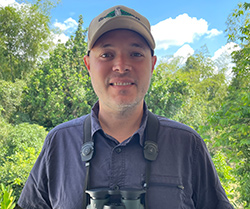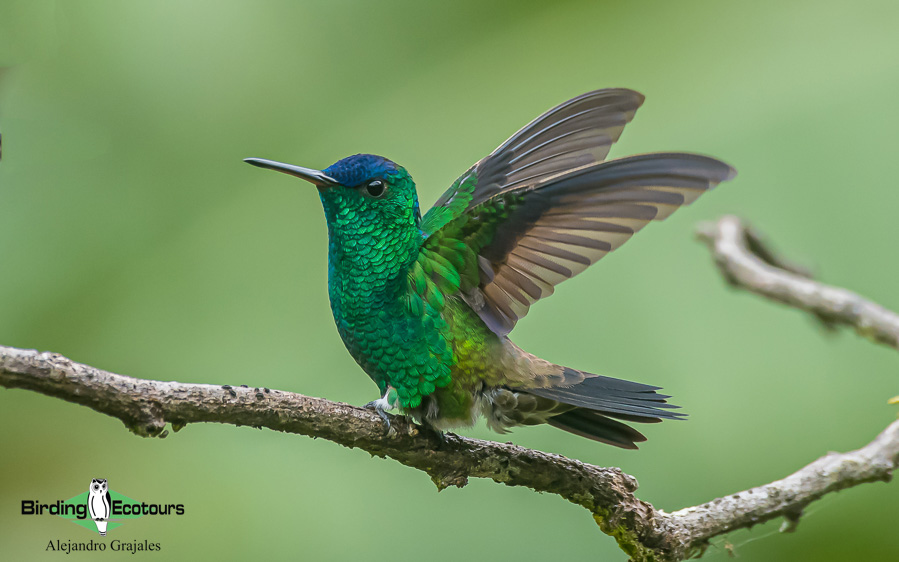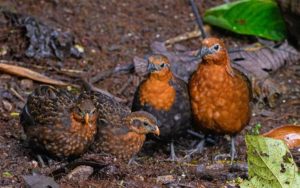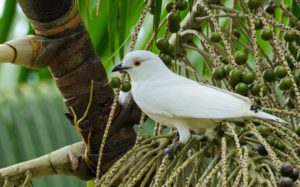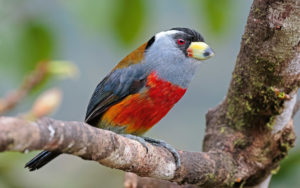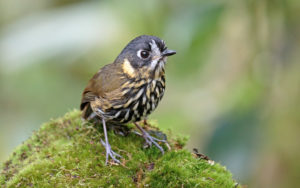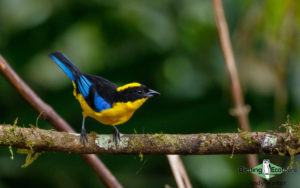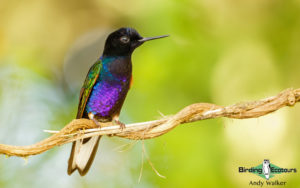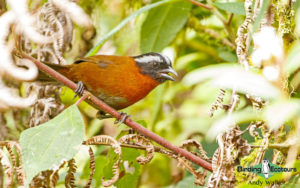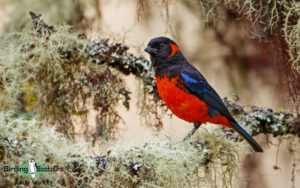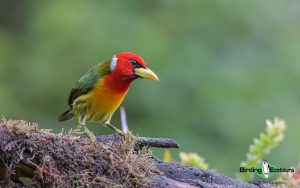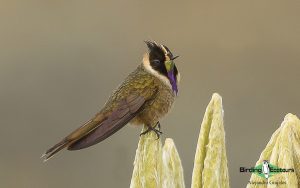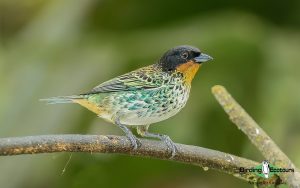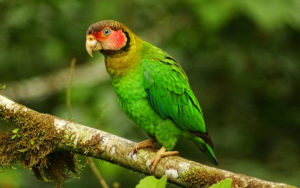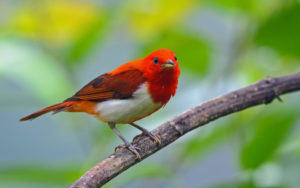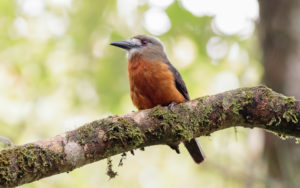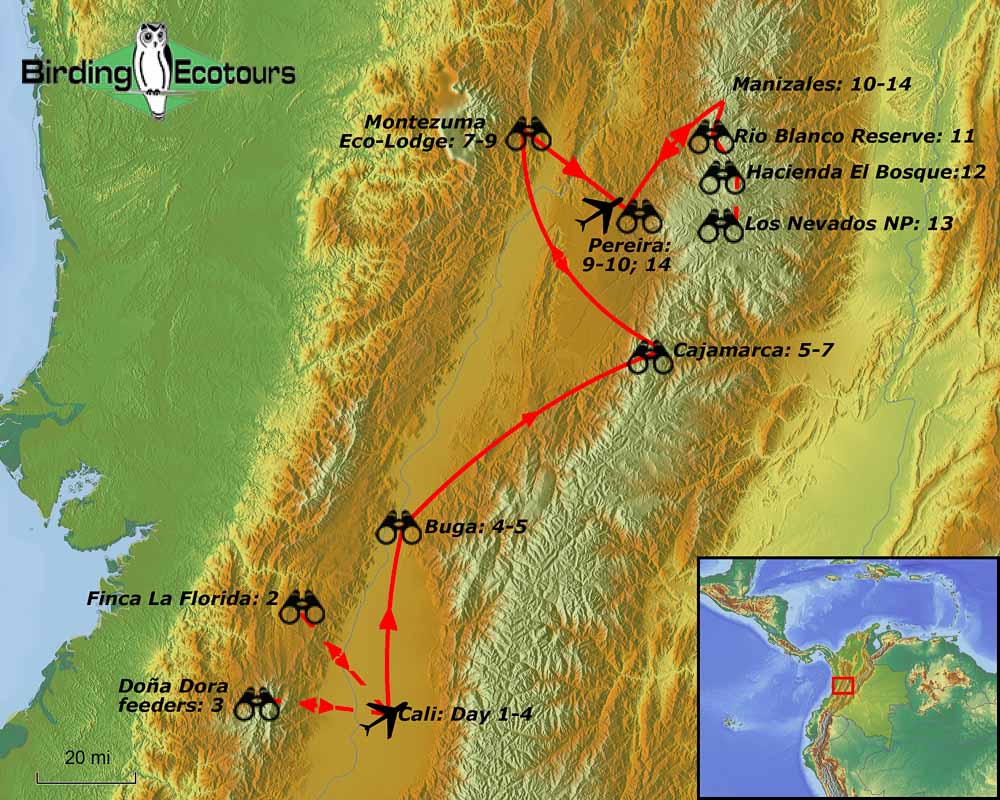The Very Best of Colombia: The Andes and Chocó
Go to: Colombia Birding Tours | Birding Tours in the Neotropics | All our birding tours
The Very Best of Colombia: The Andes and Chocó
November 2025/2026
We invite you to view our revised Colombia Birding Tour: The Very Best of Colombia itinerary. This 14-day Colombia birding tour provides some of the best birding that Colombia has to offer and will explore many of the country’s finest birding sites. We will visit the central Andes from the spectacular Los Nevados National Natural Park and the Rio Blanco Reserve in search of the most-wanted White-capped Tanager, Ocellated Tapaculo, Masked Saltator and Buffy Helmetcrest to the Otún-Quimbaya Flora and Fauna Sanctuary in search of the endemic Cauca Guan and the secretive Hooded Antpitta. At the bird-rich Tatamá National Park, where the western Andes meets the Chocó, we will search for a fine selection of Colombian birds, such as Gold-ringed (endemic), Black-and-gold and Glistening-green Tanagers, Club-winged Manakin, Chestnut-bellied Flowerpiercer, Dusky Starfrontlet, Black Solitaire and Munchique Wood Wren. We will then explore wetlands near the shores of the Cauca River in search of the endemic Apical Flycatcher, Spectacled Parrotlet and many classic aquatic species.
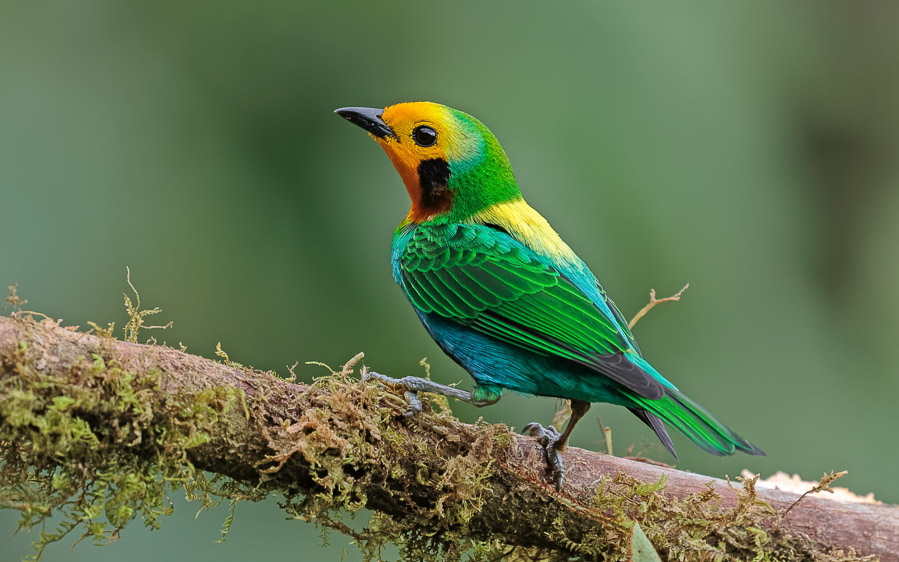
Without doubt, another highlight of this birding tour will be the Pacific lowlands, where we will have the chance to look for the most-wanted Toucan Barbet and visit the San Cipriano Reserve where it is possible to find Chocó specials such as Black-tipped Cotinga, Black-breasted Puffbird, Tawny-crested Tanager, Rufous-winged Tanager, Scarlet-and-white Tanager and the unique Sapayoa. The Pacific lowlands are home to the sought-after Ocellated Antbird, Rose-faced Parrot, Choco Toucan and Lita Woodpecker. The humid forests above Cali are home to the Multicolored Tanager, one of the most beautiful tanagers in the world.
Colombia with its many diverse habitats is home to more bird species than any other country in the world. With the country’s almost 2,000 bird species, be prepared to be in awe of its spectacular avifauna as we explore Colombia on this 14-day birding adventure. This tour can be combined with our Santa Marta Escape birding tour which takes place immediately after this tour and is centered around the endemic-rich Santa Marta Mountains in northern Colombia.
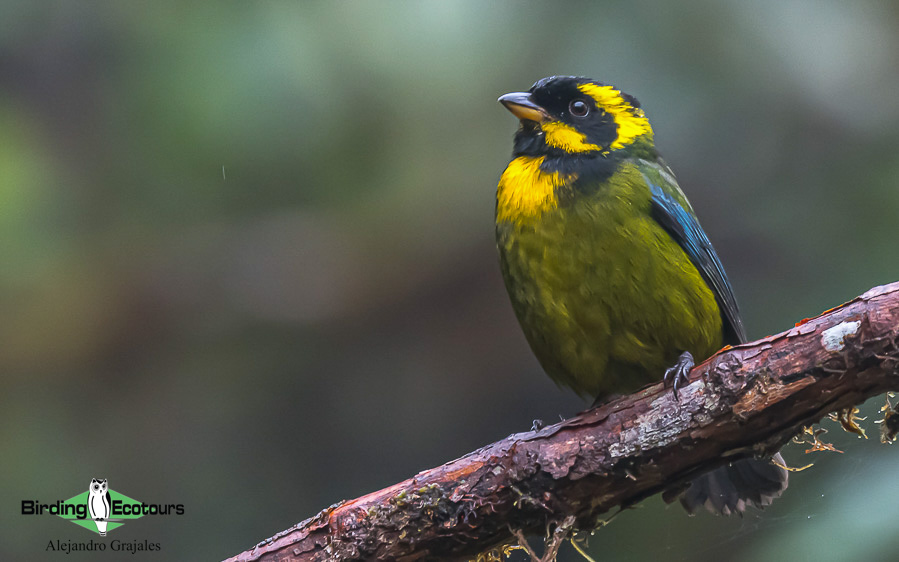
Itinerary (14 days/13 nights)
Day 1. Arrival in Cali
Our tour will start in the city of Cali, which is our rendezvous point in Colombia. You will be met at Alfonso Bonilla Aragon International Airport and then transferred to your hotel.
Overnight: Hotel Dann Carlton, Cali
Day 2. Finca La Florida and Alejandria
We will begin our tour visiting La Florida Reserve where we will spend the whole morning getting acquainted with many exciting Colombian bird species including the sought after Multicolored Tanager. The bird feeder here attracts the endemic Chestnut Wood Quail and sometimes Little Tinamou and Scaled Antpitta. Other birds to be seen in the area include Chestnut-rumped Toucanet, Red-headed Barbet, Green Honeycreeper and Saffron-crowned, Golden-naped, Summer, Flame-rumped, Metallic-green and Golden Tanagers.
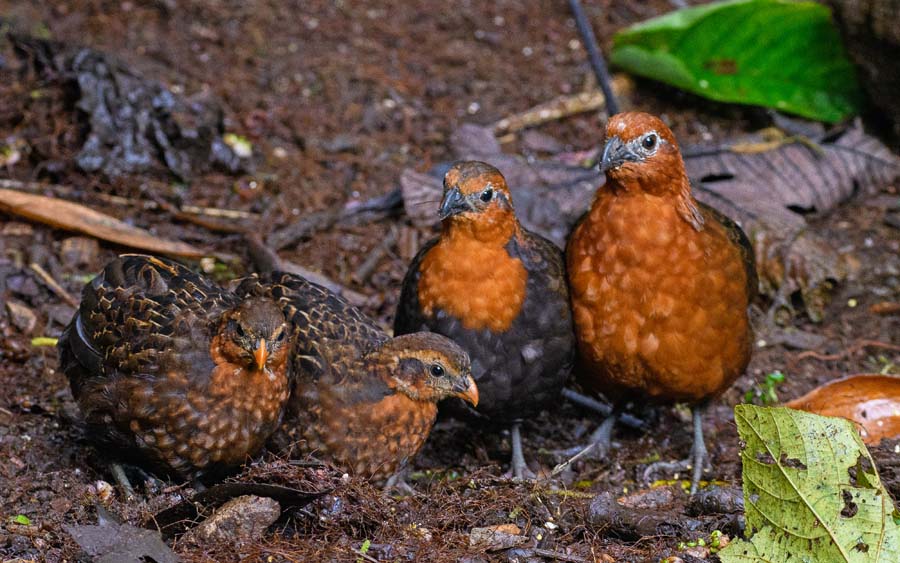
Afterwards, we will head to the famous Finca Alejandria, where we will look for hummingbirds such as Long-tailed Sylph, White-booted Racket-tail (a recent split from Booted Racket-tail), Bronzy Inca and Blue-headed Sapphire. Other species that we will search for here include the Colombian Chachalaca (endemic), Black-winged Saltator, Acorn Woodpecker, Squirrel Cuckoo, Golden-headed Quetzal, Streak-capped Treehunter, Grey-breasted Wood Wren, Chestnut-capped Brushfinch, Russet-crowned Warbler, Montane Woodcreeper, Slate-throated Whitestart and Golden-winged Manakin. If we are lucky Common Potoo may be seen at daytime roosts. Other hummingbird species on our radar here include Greenish Puffleg, White-necked Jacobin, Fawn-breasted Brilliant, Steely-vented Hummingbird, Andean Emerald, Speckled Hummingbird and Green Hermit. We will visit another private feeding station in the area where we should see similar birds, with the main target being Blue-throated Sapphire.
Overnight: Dann Carlton, Cali
Day 3. Anchicaya Road and Doña Dora feeders
Today we will visit the Doña Dora feeders, beyond the famous Kilometer 18, where we will have the chance to enjoy our first set of Chocó specials. In this area Pacific slope species reach their eastern extent and meet other more typical western Andes species. At the hummingbird feeders we normally find White-whiskered Hermit, Green Thorntail, Empress Brilliant, Violet-tailed Sylph and White-tailed Hillstar. The fruit feeders attract the most-wanted Toucan Barbet, which will be the main target of our visit. Other interesting species include Black-headed and Choco Brushfinches, Crimson-rumped Toucanet, Grey-and-gold and Rufous-throated Tanagers and Sooty-headed Wren. If neighboring trees are in fruit, it is possible to find the most-wanted Yellow-collared Chlorophonia. After another fantastic day’s birding, we will stay another night in the Cali area.
Overnight: Dann Carlton, Cali
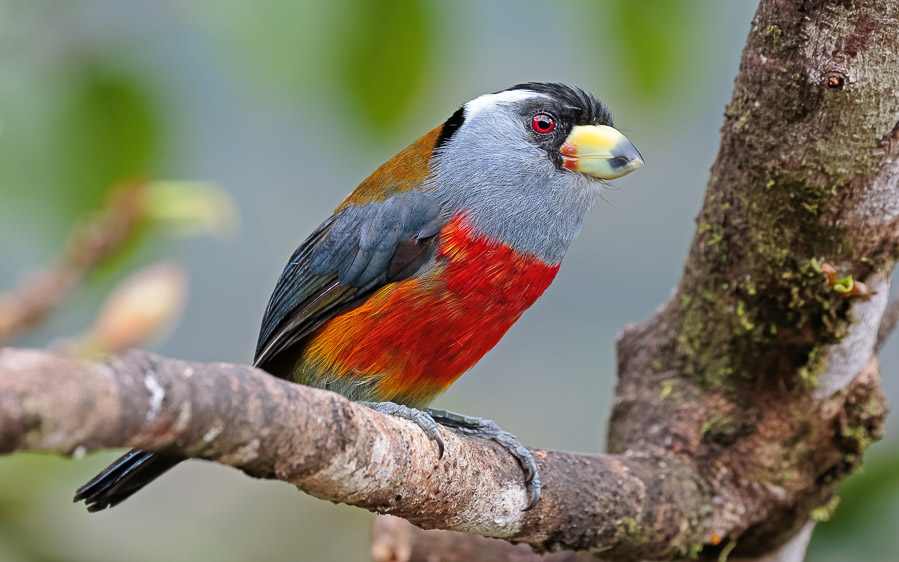
Day 4. San Cipriano Reserve and transfer to Buga
Today, we will have a very early start to travel to the San Cipriano Reserve, looking for Chocó specials such as Stub-tailed Antbird, Black-breasted Puffbird, Scarlet-thighed Dacnis, Scarlet-browed, Blue-whiskered and Scarlet-and-white Tanagers, Spot-crowned Antvireo, Dusky Pigeon, Barred Puffbird, Moustached Antwren, Chestnut-backed and Bicolored Antbirds and if we are lucky, we could find the most-wanted Ocellated Antbird, Rose-faced Parrot, Black-tipped Cotinga, Five-colored Barbet and the prized Sapayoa. From here, we will transfer to Buga.
Overnight: Hotel Guadalajara
Day 5. Sonso Lake and transfer to Cajamarca
We will have an easy morning visiting the Sonso Lake, looking for Spectacled Parrotlet, Jet Antbird, Apical Flycatcher (endemic), Orange-crowned Euphonia, Common Potoo, Common Nighthawk, Fulvous Whistling Duck, Red-breasted Blackbird, Oriole Blackbird, Blackish Rail, Greyish Piculet (endemic), several aquatic species and the secretive Dwarf Cuckoo. After 3-4 hours of birding, we will drive towards the town of Cajamarca in the foothills of the Tolima massive, a snow-capped mountain.
Overnight: Urapanes del Bosque
The gorgeous Indigo-capped Hummingbird.
Day 6. Fuertes’s Parrot Reserve
Today we will have an early start to visit the Fuertes’s Parrot Bird Reserve, one of the few places in the world where you can see the Critically Endangered and endemic Fuertes’s Parrot. Another target of this reserve is the Endangered endemic, Yellow-eared Parrot, a scarce parrot which nests at high elevation. Wax palm trees are widespread in the reserve which offer better views and photography chances than those birds seen in Jardin de Antioquia (Medellin). The new Retorno de los Colibries feeding station offers super opportunities for Colombian endemics such as Tolima Dove, Tolima Blossomcrown, Indigo-capped Hummingbird and Colombian Chachalaca. Others to look for here include Masked Trogon, Strong-billed and Montane Woodcreepers, Slaty Spinetail, Crimson-backed Tanager, White-throated and Crimson-rumped Toucanets, Andean Motmot, Olivaceous Piculet, Acorn Woodpecker, Inca Jay and Bar-crested Antshrike.
Overnight: Urapanes del Bosque
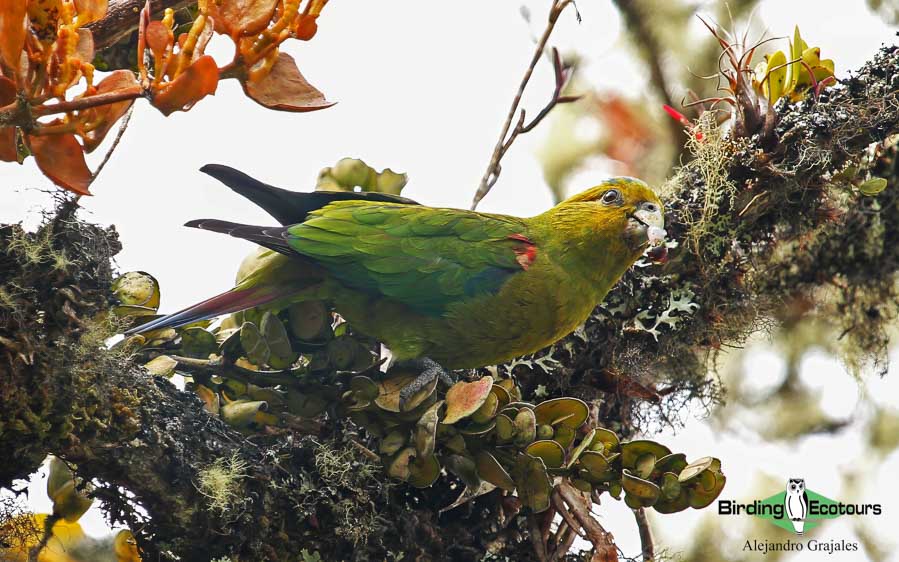
Day 7. Transfer to Montezuma
After some final birding in the area, we will transfer to Montezuma Lodge located in the foothills of the Tatama National Park, outside Pereira. This family-run property is the only accommodation in the area and although relatively basic it offers a nice experience in one of Colombia’s main birding hotspots. This is another area where Pacific slope species meet Andean species range and is one of the few accessible Chocó areas. We will arrive in the afternoon with time to check in and enjoy hummingbird feeders where we might find species such as Western Emerald, White-tailed Hillstar, Tawny-bellied Hermit and the uncommon Purple-bibbed Whitetip.
Overnight: Montezuma Eco Lodge
Day 8. Montezuma Ridge (top)
Today we will have an early start and a full day to explore the top of the Montezuma ridge at 8,530 feet (2,600 meters) above sea level, where we will look for Chestnut-bellied Flowerpiercer (endemic), Munchique Wood Wren (endemic), Smoky Bush Tyrant and Collared Inca. We will also look for incredible mixed-species flocks that make Montezuma famous, which often include Gold-ringed (endemic), Glistening–green, Black-and-gold and Purplish-mantled Tanagers, Chestnut-breasted Chlorophonia, Fulvous-dotted Treerunner, Spillmann’s, Narino and Tatama Tapaculos, Montane Woodcreeper, Indigo Flowerpiercer, Ochre-breasted Antpitta, Bronze-olive Pygmy Tyrant, Handsome Flycatcher and with luck, White-faced Nunbird and Tanager Finch. The hummingbird feeders below the ridge attract Tourmaline Sunangel, Velvet-purple Coronet, Greenish Puffleg, Violet-tailed Sylph, Empress Brilliant and Brown Inca. At night we will look for Tropical Screech Owl around the cabins.
Overnight: Montezuma Ecolodge
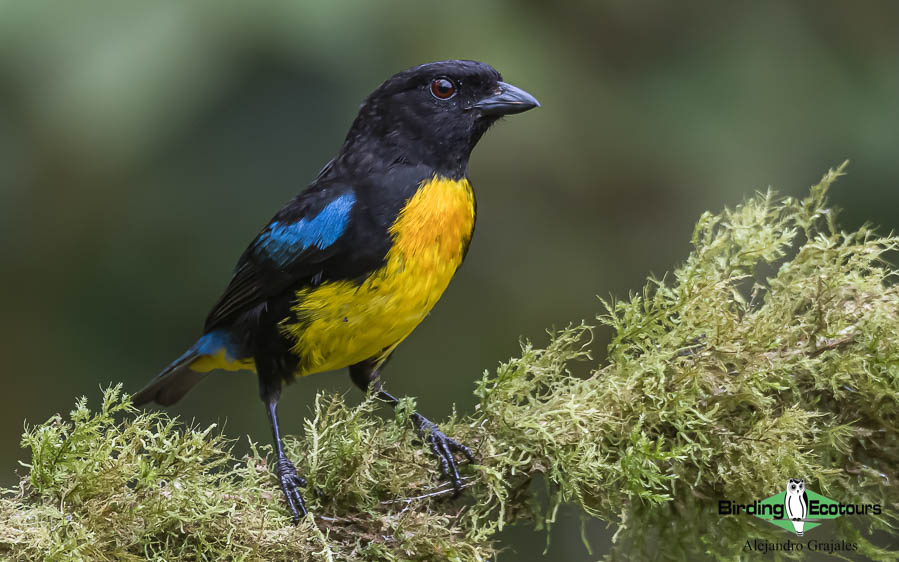
Day 9. Montezuma (mid-elevation) and transfer to Pereira
We will have another early start today, this time to focus on mid-elevation species in the Cajones sector of the park. Here we will look for Orange-breasted Fruiteater, Crested and Golden-headed Quetzals, Uniform Treehunter, Buff-fronted Foliage-gleaner, Uniform Antshrike, Bluish Flowerpiercer, Black-and-gold (endemic) and Rufous-throated Tanagers, Pacific Tuftedcheek, Choco Brushfinch, Choco Vireo, Golden-winged Manakin, Black-throated Tody-Tyrant, , Yellow-collared Chlorophonia, Crested Ant Tanager and with luck, Black Solitaire, Scaled Fruiteater, Choco Vireo and Beautiful Jay. In the early afternoon we will leave the reserve and transfer to Pereira for the night in a comfortable hotel.
Overnight: Movich Pereira Hotel
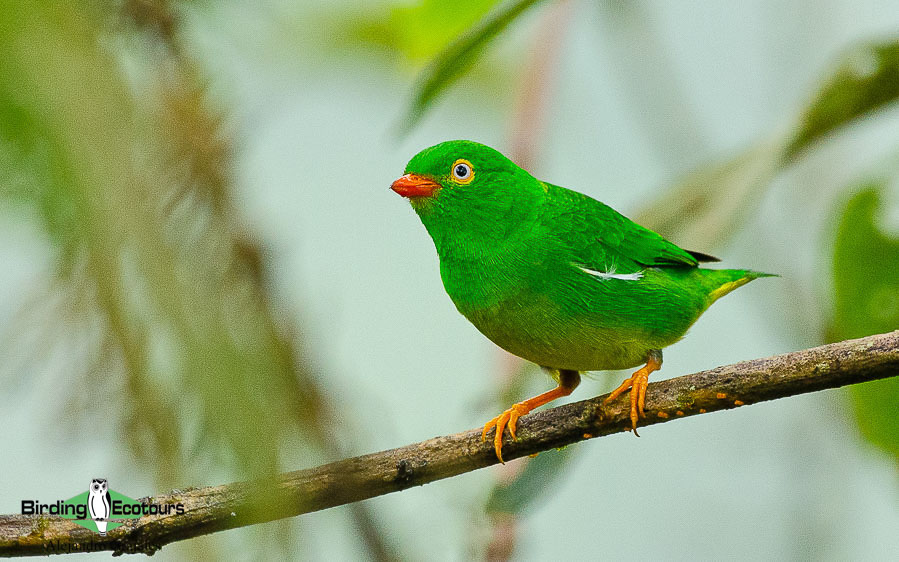
Day 10. Otún-Quimbaya Sanctuary and transfer to Manizales
Our predawn start will involve a drive from Pereira to the Otún-Quimbaya Flora and Fauna Sanctuary, where we will look for the endemic Cauca Guan and the secretive Hooded Antpitta. Other birds to look for here include Red-ruffed Fruitcrow, Rufous-breasted Flycatcher, Chestnut-breasted Wren, Crested Ant Tanager (endemic), Andean Motmot, White-throated Toucanet, Stiles’s Tapaculo (endemic), Streak-capped Treehunter, Sooty-headed and Torrent Tyrannulets, Slaty-backed Chat-Tyrant, Whiskered Wren, White-capped Dipper and Torrent Duck. After lunch we will drive to Manizales, our base for the next few days.
Overnight: Hotel Quo, Manizales
Day 11. Rio Blanco Reserve
Today we will spend the morning visiting the Rio Blanco Reserve, paying particular attention to the three different antpitta stations of this reserve to look for Bicolored, Chestnut-crowned, Brown-banded and Slate-crowned Antpittas. The mixed-species flocks at Rio Blanco normally include Blue-and-black, Grass-green and Blue-capped Tanagers, Blue-winged Mountain Tanager, Capped Conebill, Black-eared Hemispingus, Superciliaried and Oleaginous Hemispingus, Crimson-mantled Woodpecker, Pearled Treerunner and Green-and-black Fruiteater. Some understory species we will look for include Rusty-crowned Tody-Flycatcher, Flammulated Treehunter, Streak-headed Antbird, Blackish Tapaculo, Russet-crowned Warbler and Grey-browed Brushfinch. Other highlight species to look for at Rio Blanco include Masked Saltator, Dusky Piha and White-capped Tanager. Occasionally it is possible to find Stygian Owl at its daytime roost.
Overnight: Hotel Quo, Manizales
Day 12 Hacienda El Bosque
Today we will spend the full morning at Hacienda El Bosque, a private reserve which has become a mandatory birding and photography hotspot for birdwatchers visiting Colombia. Here we will have the chance to look for the sought after Crescent-faced Antpitta. Other targets include Equatorial Antpitta, White-browed Spinetail, White-banded and White-throated Tyrannulets, Mountain, Rufous and Grass Wrens, Black-crested Warbler, Blue-backed Conebill, White-throated Quail-Dove, Grey-browed Brushfinch and Hooded Mountain Tanager. While here we will also enjoy the lodge feeders which attract handsome species such as Grey-breasted Mountain Toucan, a big target for many visitors, and this reserve offers close up views of this species. Other interesting species seen here include Andean and Sickle-winged Guans. Hummingbirds will of course be high on our agenda here and include Sword-billed Hummingbird, Tourmaline Sunangel, Buff-winged Starfrontlet, Mountain Velvetbreast, Shining Sunbeam and many others.
Overnight: Hotel Quo, Manizales
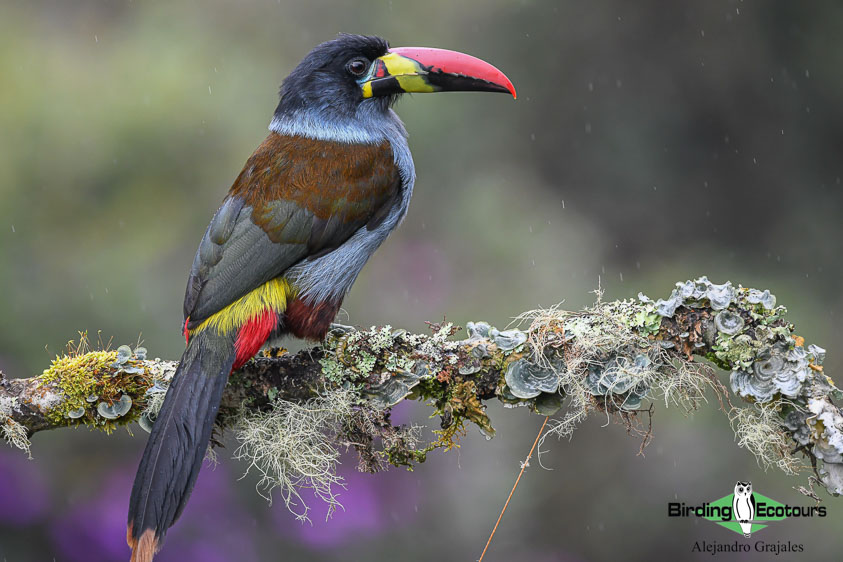
Day 13. Los Nevados National Natural Park
Today we will have an early start to explore the high elevation páramos below the snow-capped mountains. Outside the park we will look for Buffy Helmetcrest (endemic), Andean Tit-Spinetail, Many-striped Canastero, Grass Wren, Tawny Antpitta, Plain-colored Seedeater, Plumbeous Sierra Finch and Stout-billed Cinclodes. If we are lucky, we might see the mighty Andean Condor soaring above the mountains alongside the commoner Black-chested Buzzard-Eagle. We will try to locate the uncommon Black-backed Bush Tanager before returning to our hotel and enjoying its hummingbird feeders. These feeders attract species like Great Sapphirewing, Buff-winged Starfrontlet, Mountain Velvetbreast, Black-thighed and Golden–breasted Pufflegs, Shining Sunbeam, Viridian Metaltail and Rainbow-bearded Thornbill. Other species around the hotel include Paramo Tapaculo, Glossy Flowerpiercer and Pale-naped Brushfinch.
Overnight: Hotel Quo, Manizales
Day 14 Transfer to Pereira and departure
Today we will transferr to Pereira domestic airport where we will say goodbye and catch domestic flights back to Cali, Bogota or Medellin from where you can take international flights back home.
Please note that the itinerary cannot be guaranteed as it is only a rough guide and can be changed (usually slightly) due to factors such as availability of accommodation, updated information on the state of accommodation, roads, or birding sites, the discretion of the guides and other factors. In addition, we sometimes have to use a different guide from the one advertised due to tour scheduling or other factors.
Download ItineraryThe Very Best of Colombia Trip Report, February 2020
18 FEBRUARY – 17 MARCH 2020
DOWNLOAD TRIP REPORT
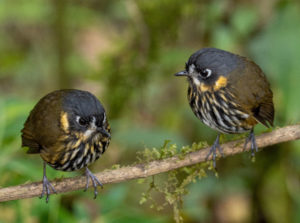
Overview
Our 19-day Colombia tour 2020 was a fabulous experience, which allowed us to see probably the best birding route of the country and most of the highlights that this amazing land has to offer to birdwatchers and truly adventurous travelers. No other country holds more avian species than Colombia, and we had the chance to see some of the most spectacular birds in this part of the world and finished the tour with most of the Neotropical families well represented on our list.
The Colombia 2020 tour was an easy trip for a group of very enthusiastic photographers who also wanted to contemplate the birds, became familiar with them, and admire their natural behavior at a more relaxed pace than the usual birding pace. Instead of working on a long list of species we tried to photograph as many birds as possible, and even though the total was not as large as in previous years we did remarkable well for our easy pace, getting 513 species recorded. This total includes 63 species of hummingbirds, 83 species of tanagers and allies, 27 Colombian endemics, and a good set of locally restricted birds found in Colombia and adjacent Venezuela and/or Ecuador only. Our list includes breathtaking and endemic species such as Crescent-faced Antpitta, Hooded Antpitta, Moustached Antpitta, Gold-ringed Tanager, Black-and-gold Tanager, Blue-whiskered Tanager, Baudo Guan, Cauca Guan, Chestnut Wood Quail, Buffy Hummingbird, Tocuyo Sparrow, White-tipped Quetzal, Keel-billed Toucan, Tooth-billed Hummingbird, Scarlet Ibis, Santa Marta Blossomcrown, Rusty-faced Parrot, Golden-chested Tanager, Mountain Avocetbill, Lita Woodpecker, Club-winged Manakin, Orange-breasted Fruiteater, Golden-breasted Fruiteater, Black Solitaire, Beautiful Jay, Santa Marta Warbler, Chivi Vireo, and Lemon-spectacled Tanager among many other jewels. We had fun from beginning to end and learned a lot about the distribution of species in one of the countries with the most complex geography in the Americas.
Detailed Itinerary
Day 1. Arrival at Barranquilla and transfer to the hotel
Our trip started in Barranquilla, where the group arrived on different flights, and the participants were transferred to our comfortable hotel in town.
Day 2. Barranquilla and transfer to Riohacha
The following morning we left Barranquilla and drove to the outskirts, where we started birding. We had an amazing start with species such as the endemic Chestnut-winged Chachalaca, Brown-throated Parakeet, Orange-winged Amazon, and Bicolored Wren around the scrub. Then we drove to the famous Km 4, where we saw several attractive species, including Blue-winged Teal, Scaled Dove, Black-necked Stilt, Groove-billed Ani, Red-crowned Woodpecker, Northern Crested Caracara, Carib Grackle, Stripe-backed Wren, and Russet-throated Puffbird. From here we continued driving toward Riohacha, and on the way we saw Brown Pelican, Laughing Gull, Willet, and Semipalmated Plover. After passing the city of Santa Marta we stopped at Las Gaviotas, where we saw Crimson-backed Tanager, Blue Dacnis, White-necked Puffbird, Lance-tailed Manakin, and Ruby-topaz Hummingbird working on the flowers, a most-wanted species of hummingbird in Colombia. Finally we arrived at Riohacha in the department of La Guajira, where we spent the night in a comfortable hotel.
Day 3. La Guajira and Camarones
Today we had a full day to explore the deciduous dry habitat of Guajira and Camarones.
We had an early start in the company of our local guide Jose, who belongs to an indigenous American ethnic group called Wayuu that inhabits the territory. This community lives on the Guajira Peninsula of Colombia with a small population in northwest Venezuela.
The first species we looked for was Tocuyo Sparrow; with the help of our local guide we found it thanks to the knowledge of the territory of our guide, since this is one of the most difficult and sought-after species in the area. Other species that we saw were Chestnut Piculet, Merlin, Bare-eyed Pigeon, and Red-billed Emerald.
Then we visited a new birding facility where the owner started feeding birds and increased the chances to see some great classic species like Vermilion Cardinal, and other species that visit the feeders are Orinoco Saltator, Grey Pileated Finch, Buffy Hummingbird, Tropical Mockingbird, Scaled Dove, Yellow Oriole, Bananaquit, and Greyish Saltator.
We explored the dry surroundings of Guajira, where we saw Crested Bobwhite, Northern White-fringed Antwren, Black-crested and Black-backed Antshrikes, Slender-billed Inezia, White-whiskered Spinetail, Russet-throated Puffbird, Black-faced Grassquit, Green-rumped Parrotlet, Scaled Dove, and Pearly-vented Tody-Tyrant.
At the end of the morning, we moved to the shores of Camarones, where we spent the remainder of the day. Here we had good views of American White Ibis, Scarlet Ibis, Reddish Egret, Royal Tern, Caspian Tern, Common Tern, and Least, Semipalmated, and Western Sandpipers, as well as thousands of American Flamingos.
Day 4. Transfer from Riohacha to Taironaka
Today we left Riohacha and transferred to the Hotel Taironaka Turismo Ecológico y Arqueología in Don Diego.
We left our vehicle and took a small boat to get to this paradise in the Caribbean jungle. It is the best way to get to the hotel. Another way is to walk to it through the forest, but this is not a good option considering luggage.
We started birding the road around the hotel and had good views of Orange-chinned Parakeet, Piratic Flycatcher, Social Flycatcher nesting, the fantastic Keel-billed Toucan, King Vulture, Lineated Woodpecker, Barred Antshrike, Plain Xenops, and Buff-breasted Wren.
Day 5. Taironaka and transfer to Minca
The next morning we explored a different road near the lodge. We were lucky to see Gartered Trogon, Whooping Motmot, Crested Oropendola, and Streaked Flycatcher. When we found an army ant swarm we had great views of Grey-headed Tanager, Plain-brown Woodcreeper, White-shouldered Tanager, and Crimson-backed Tanager. Then we moved close to the Don Diego River and were able to observe Collared Aracari, Military Macaw, Spotted Sandpiper, Neotropic Cormorant, White-bearded Manakin, and Prothonotary Warbler.
We left Taironaka and drove to Minca, a town located at the lowest parts of the Santa Marta Mountains. At our hotel, La Casona de Minca, we keep ourselves busy with the feeders for the rest of the afternoon, enjoying species such as Pale-bellied Hermit, White-vented Plumeleteer, Rufous-tailed Hummingbird, White-necked Jacobin, Keel-billed Toucan, Black-chested Jay, Clay-colored Thrush, Crested Oropendola, and White-tipped Dove.
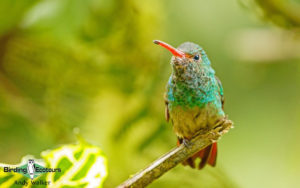
Day 6. Minca and transfer to El Dorado Lodge
The next morning we started our birding above Minca, finding species such as Golden-winged Sparrow, Rufous-capped Warbler, Keel-billed Toucan, Lineated Woodpecker, Masked Tityra, Bicolored Wren, White-lined Tanager, Rose-breasted Grosbeak, Buff-throated Saltator, Summer Tanager, and Broad-winged Hawk. We climbed into higher elevations and there were happy to see the toddi subspecies of Broad-winged Hawk, which is endemic to the Santa Marta Mountains, and also Santa Marta Antbird, Santa Marta Foliage-gleaner, Swallow Tanager, and Plumbeous Kite. Later we had great views of a number of endemics, namely Santa Marta Woodstar, Santa Marta Blossomcrown, and Santa Marta Brushfinch, and we also saw Rusty Flowerpiercer and Groove-billed Toucanet.
We arrived at El Dorado Lodge at lunchtime and found a hummingbird frenzy at the lodge feeders with views of Crowned Woodnymph, Brown Violetear, Lesser Violetear, and Lazuline Sabrewing, while the tanager feeders provided Blue-naped Chlorophonia and Black-capped Tanager. Around the lodge we saw White-tipped Quetzal and Golden-breasted Fruiteater.
We spent some time observing the compost, where we could only see a few White-tipped Doves; at this time of year there is not much activity at the compost.
In the evening we went out to look for Santa Marta Screech Owl around the hotel, but we had no luck.
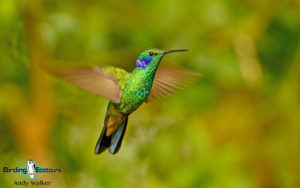
Day 7. San Lorenzo Ridge
The San Lorenzo Ridge was our location for the next morning. We had a predawn start in order to be at the ridge by dawn. Once we arrived there we had our field breakfast and started to look for birds. We had an incredible start, getting many of the Santa Marta endemics such as Rusty-headed Spinetail, Streak-capped Spinetail, Santa Marta Mountain Tanager, Santa Marta Brushfinch, Yellow-crowned Whitestart, and Santa Marta Warbler. We also saw Scarlet-fronted Parakeet, Hermit Wood-Wren, Black-backed Thornbill and White-throated Toucanet. Later we drove to the San Lorenzo Field Station, where we had amazing views of two Santa Marta Antpittas at feeding station.
For lunch we drove back to the lodge, where we later had great views of White-tipped Quetzal and Golden-breasted Fruiteater, White-lored Warbler, Golden Grosbeak, Rufous-browed Peppershrike, Masked Trogon, and Band-tailed Guan near the lodge grounds.
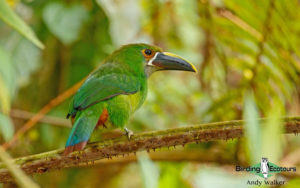
Day 8. El Dorado Lodge, transfer to Santa Marta, and flight to Pereira
We spent a couple of hours trying to improve on our the photos at the hotel feeders and then we headed to the airport at Santa Marta, from where we successfully started our flight via Bogotá to the city of Pereira.
Day 9. Otún-Quimbaya Fauna and Flora Sanctuary
Today we went to the Otún-Quimbaya Fauna and Flora Sanctuary for a full day of birding, During the morning we enjoyed Torrent Tyrannulet, Blue-necked Tanager, Canada, Blackburnian, and Three-striped Warblers, and Moustached Puffbird.
We had lunch in the reserve and afterwards continued birding along the main road, finding the uncommon Wattled Guan, the endemic Cauca Guan, White-capped Parrot, the secretive Moustached Antpitta, Red-ruffed Fruitcrow, Rufous-breasted and Slaty-capped Flycatchers, Inca Jay, Grey-breasted Wood Wren, Andean Solitaire, the endemic Crested Ant Tanager, and Flame-rumped Tanager.
Day 10. Transfer to Montezuma Eco-Lodge
A full morning at Otún-Quimbaya started with an early rough drive to El Cedral at the top of the road. Here we saw the super-rare Hooded Antpitta and other species such as Collared Trogon, Andean Motmot, Chestnut-crowned Antpitta, Bronze-olive Pygmy Tyrant, Black-billed Peppershrike, Orange-billed Nightingale-Thrush, Swainson’s Thrush, and the endemic Stiles’s Tapaculo. We also looked for birds around the hotel, hoping for better photography opportunities; some of the species we saw were Blue-grey Tanager, Cauca Guan, Blue-necked Tanager, Black-winged Saltator, and Black-billed Thrush.
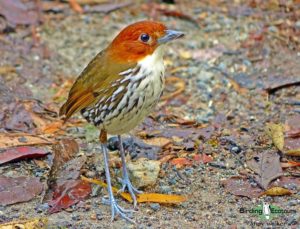
Then we drove to Montezuma Eco-Lodge, the gateway to Tatamá National Park. On the way we made a couple of stops looking for Turquoise Dacnis, but we didn’t have any luck and saw only the usual suspects such as Blue-grey Tanager, Tropical Pewee, Black-billed Thrush, Green Honeycreeper, and Blue-headed Parrot.
In order to explore Tatamá National Park, where the Pacific Chocó lowlands meet the Western Andes, we planned staying three nights at the Montezuma Eco-Lodge as our base in order to investigate the forest above the lodge and find the jewels that this place holds. But not only birdwatchers visit this park but also a good number of butterfly aficionados from different parts of the world due to the fact that Tatamá holds one of the largest concentrations of butterfly species in Colombia.
We drove through the town of Pueblo Rico, and it was interesting to see how the town became very much alive, especially in the main square. There were lots of people and all kinds of different characters chilling out around the square. Colombian folk music was playing loudly from different local pubs, and several old 4×4 jeeps were parked around the square.
We arrived late in the afternoon at the lodge with just enough time to look at the hummingbird feeders and enjoy Empress Brilliant, Rufous-gaped Hillstar, Crowned Woodnymph, Velvet-purple Coronet, Rufous-tailed Hummingbird, and Western Emerald. The fruit feeders attracted Silver-throated, Crimson-backed, Golden, and Lemon-rumped Tanagers and Black-winged Saltator. After a delicious dinner we went to sleep to get ready for the next day.
Day 11. Tatamá National Park (upper parts)
We met in the dining room in order to get some coffee and then left toward the top of the ridge in Tatamá National Park. After an hour (10-km drive) we arrived at the top at dawn and had our delicious field breakfast with amazing views of the mountain forest. Tatamá National Park is somehow remote, and the only people using this road are the members of the Montezuma Eco-Lodge and the Colombian army that still has a small military base at the top of the ridge.
Our first encounter was with a couple of Swallow-tailed Nightjars on the road. During breakfast we saw Collared Inca, Buff-tailed Coronet, and Black-and-white Seedeater, followed by the first endemic of the day, Chestnut-bellied Flowerpiercer. After great views of this endemic we started looking for the second target of the ridge, Munchique Wood Wren, which is also a range-restricted country endemic.
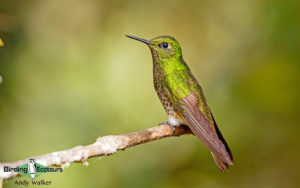
We spent the day exploring the area between the ridge and mid-elevations, focusing more on the upper parts. In the morning we enjoyed views of the endemic Gold-ringed Tanager and of Black-chinned Mountain Tanager, Grass-green Tanager, Lacrimose Mountain Tanager, Purplish-mantled Tanager, the endemic Black-and-gold Tanager, Rufous Spinetail, Green-and-black Fruiteater, Orange-breasted Fruiteater, Tyrannine Woodcreeper, Scaly-throated Foliage-gleaner, Beautiful Jay, Golden-fronted Whitestart, and the recently described endemic Tatama Tapaculo (April 2017), known previously as Alto Pisones Tapaculo.
The hummingbird feeders at high- and mid-elevations provided excellent views of Velvet-purple Coronet, Brown Inca, Collared Inca, Tourmaline Sunangel, Greenish Puffleg, and Violet-tailed Sylph. We returned to the lodge in the afternoon and spent the rest of the day birding in the gardens and enjoying the hummingbird feeders.
Day 12. Tatamá National Park (mid-elevations)
Today we repeated the same formula, leaving the lodge before dawn and focusing on mid-elevation species this time.
We started the morning with Masked Trogon and Tawny-bellied Hermit. We heard the endemic Chestnut Wood Quail distantly and enjoyed Andean Motmot, Pacific Tuftedcheek, Montane Woodcreeper, Ochre-breasted Antpitta, Ornate, Handsome, and Cinnamon Flycatchers, Barred Becard, Sharpe’s Wren, Chestnut-capped Brushfinch, Choco Brushfinch, Yellow-throated Bush Tanager, Glistening-green Tanager, Chestnut-breasted Chlorophonia, Brown-billed Scythebill, and Olive Finch. At lower elevations we managed to get crippling views of Dusky Bush Tanager and the endemic Black-and-gold Tanager.
We went back to the lodge after having spent the whole morning by the road and focused on the gardens in the afternoon. We explored the area around the headquarters, having a lovely encounter with the endemic Greyish Piculet and also finding Chestnut-headed Oropendola, Red-headed Barbet, Bar-crested Antshrike, Smooth-billed Ani, House Wren, and other classic birds of open grounds and secondary growth.
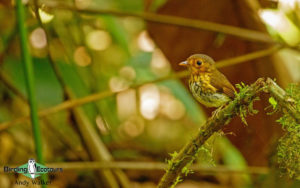
Day 13. Montezuma Eco-Lodge and transfer to Rio Blanco Nature Reserve
We birded Montezuma the next morning looking and found species like Purple-throated Woodstar, Broad-billed Motmot, Yellow-throated Toucan, Zeledon’s Antbird, Chestnut-crowned Gnateater, Choco Tapaculo, Ruddy Foliage-gleaner, Purple-throated Fruitcrow, Sooty-headed Wren, and Ochre-breasted Tanager. Then we left Montezuma and headed to Manizales and the famous Rio Blanco Reserve, making this day basically a traveling day.
Day 14. Rio Blanco Nature Reserve
Today we started birding the Rio Blanco Nature Reserve, which is run by the Aguas de Manizales municipal and regional program. This reserve protects the forest and conserves water sources for the town of Manizales and for many years has been providing tourist facilities for birdwatchers, including accommodation, food, guided visits, and the famous antpitta feeding stations.
We checked the hummingbird feeders and saw Collared Inca, Long-tailed Sylph, Buff-tailed Coronet, and Tourmaline Sunangel. Masked Flowerpiercer and Buff-breasted Mountain Tanager were also around. By 7:00 a.m. we and other birders were called to visit the first antpitta feeding station, which was just next to the house. Here we saw Bicolored Antpitta, which was close and showed nicely. We followed the person in charge of the antpitta feeders, who took us to the next station, where we had incredibly close-up views of the endemic Brown-banded Antpitta and the widespread Chestnut-crowned Antpitta. Grey-browed Brushfinch and Green-and-black Fruiteater were seen here as well.
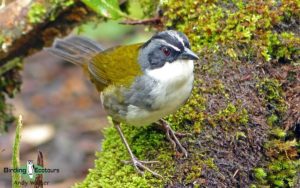
After the show was over we continued birding, finding nice mixed flocks with Black-eared Hemispingus, the uncommon Rusty-faced Parrot, the lovely Golden-plumed Parakeet, Capped Conebill, Brown-capped Vireo, Superciliaried Hemispingus, Grey-hooded Bush Tanager, Slaty Brushfinch, Blue-and-black Tanager, Glossy-black Thrush, Black-billed Peppershrike, Crimson-mantled Woodpecker, Azara’s Spinetail, Pearled Treerunner, Streaked Xenops, and Strong-billed and Montane Woodcreepers. We also noticed Band-tailed Pigeon, Sickle-winged Guan, Masked Trogon, and Yellow-bellied Chat-Tyrant.
After lunch we took a break and met again in the afternoon to bird the lower road. The activity was rather slow in the afternoon, with the same mixed flock described above but with fewer species that, however, included White-bellied Woodstar, White-throated Wedgebill, White-capped Dipper, and Blue-capped Tanager. We spent the night at Rio Blanco.
Day 15. Hacienda el Bosque and Los Nevados National Natural Park
The next day we drove to Hacienda el Bosque, a new place that also provides feeding stations. We enjoyed Grey-browed Brushfinch, Rufous Antpitta, Sword-billed Hummingbird, Brown-backed Chat-Tyrant, Black-crested Warbler, White-sided Flowerpiercer, Paramo Seedeater, and the super-rare Crescent-faced Antpitta.
We continue to Los Nevados National Natural Park to the highest part of the road in search of the endemic Buffy Helmetcrest, where we saw it successfully. We also saw other species along the way, such as Andean Duck, Stout-billed Cinclodes, White-chinned Thistletail, Plumbeous Sierra Finch, and Plain-colored Seedeater.
Our accommodation, the Hotel Termales Del Ruiz, had fabulous hummingbird feeders, and we enjoyed Shining Sunbeam, Golden-breasted Puffleg, Mountain Velvetbreast, Great Sapphirewing, Viridian Metaltail, Sword-billed Hummingbird, Rufous-capped Thornbill, and Buff-winged Starfrontlet. We saw Lacrimose Mountain Tanager and Scarlet-bellied Mountain Tanager around the feeders as well and enjoyed Purple-backed Thornbill and Pale-naped Brushfinch.
Day 16. Transfer to Calí and Sonso Lake
In the morning we walked near the hotel, looking for different species of high-elevation areas such as Buff-winged Starfrontlet, White-banded Tyrannulet, White-throated Tyrannulet, Brown-bellied Swallow, and Band-tailed Pigeon. Sadly the localized Rufous-fronted Parakeet was not found this time.
We then started our long drive to the city of Calí, but on the way we made a quick stop at Sonso Lake. Located at the edge of the Cauca River, this wetland ecosystem of 2045 hectares holds an interesting set of waterfowl and aquatic species like Black-bellied Whistling Duck, Greater Ani, Common Nighthawk, Common Potoo, Jet Antbird, Cocoa Woodcreeper, Slaty-headed Tody-Flycatcher, the endemic Apical Flycatcher, and Streaked Flycatcher. Then we continued to Calí, where we spent the night.
Day 17. The Anchicaya road
We started early the next morning, moving from Calí to the Anchicaya road, staying one night at El Queremal. The old Anchicaya road used to join Calí with the Pacific lowlands, especially the port of Buenaventura, and today, after a new road has been built, provides incredible birding with very attractive species. As soon as we arrived we went to Doña Dora, a local woman who owns a small, basic restaurant located below El Queremal. On the feeders we had dynamite views of Toucan Barbet, Silver-throated Tanager, Scrub Tanager, the endemic Flame-rumped Tanager, Black-headed Brushfinch, Empress Brilliant, Purple-bibbed Whitetip, Rufous-throated Tanager, and White-whiskered Hermit.
We continued enjoying different species on the Anchicaya road, such as a female Lyre-tailed Nightjar, Scale-crested Pygmy Tyrant, Pacific Flatbill, Yellow-throated Bush Tanager, Tricolored Brushfinch, Scarlet-browed Tanager, and Grey-and-gold Tanager. Later we moved to our basic hotel in El Queremal for an overnight.
Day 18. Anchicaya road, transfer to Calí
The next day we went to visit lower areas of the Anchicaya road that have only recently been opened to foreign visitors, and we had an incredible day. We started with views of Choco Toucan, Spot-crowned Barbet, Rufous-tailed Jacamar, Collared Aracari, Cinnamon Woodpecker, Lita Woodpecker, Spotted Woodcreeper, Pacific Antwren, Golden-faced Tyrannulet, and Lemon-browed Flycatcher and had a wonderful encounter with Purple-crowned Fairy. In addition we enjoyed Slaty-capped Shrike-Vireo, Bay Wren, several Tawny-crested Tanagers, Golden-hooded Tanager, Lemon-spectacled Tanager, Scarlet-and-white Tanager, the spectacular Golden-chested Tanager, the localized Baudo Guan, White-tipped Sicklebill, Rufous Motmot, and Broad-billed Motmot. We took a packed lunch with us and enjoyed a tasty local meal near the lek of the amazing Tooth-billed Hummingbird and had super views of this most-wanted species.
Then we drove to Calí after an intense day in the field.
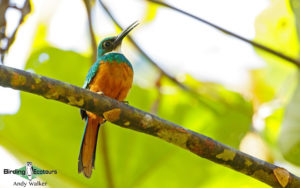
Day 19. Finca Florida, Finca Alejandría, departure
On our last morning we went to Finca Florida el Bosque de las Aves, located near Calí at the famous Km 18, where they have feeders and we started with beautiful views of endemics and unique species like Chestnut Wood Quail, Colombian Chachalaca, and the enigmatic Multicolored Tanager. We enjoyed other species like Saffron-crowned Tanager, Red-headed Barbet, Chestnut-capped Brushfinch, and Green Honeycreeper.
Then we visited the famous Finca Alejandría “El Paraiso de Los Colibries”, where we had an amazing start with species such as the near-endemic Scrub Tanager, Crimson-rumped Toucanet, and Squirrel Cuckoo around the gardens. The fruit feeders attracted several captivating species including Golden Tanager, Golden-naped Tanager, Saffron-crowned Tanager, Black–winged Saltator, Flame-rumped Tanager, Summer Tanager, and Red-headed Barbet, and we had cracker views of the incredibly beautiful Multicolored Tanager, perhaps one of the most handsome Colombian endemics!
With our international flights from the Calí airport later in the day a fabulous adventure came to an end, full of incredible and wonderful memories of yet another successful Birding Ecotours Colombia tour. We had an excellent time visiting some of the best places in Colombia, enjoyed the delicious food, and got to know some of the richest bird regions in the whole country – a very productive trip with great photo opportunities and wonderful landscapes.
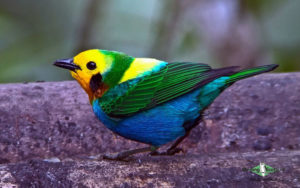
Please see the downloadable PDF above for the full species lists. This is a sample trip report. Please email us ([email protected]) for more trip reports from this destination.
COLOMBIA: THE VERY BEST OF COLOMBIA
TOUR-SPECIFIC INFORMATION
PLEASE CLICK HERE FOR GENERAL INFORMATION PERTAINING TO OUR COLOMBIA TOURS IN GENERAL
The birding on this Colombia tour is simply outstanding, both in terms of numbers and diversity of species. This itinerary is designed to provide you with the best of the country, from the central Andes, including the high Andean Mountains of Los Nevados National Park and the Rio Blanco Reserve, to the Chocó rainforest, and the western Andes. We believe you are going to love your Colombian birding tour with us!
ARRIVAL INFORMATION
Please e-mail us (or contact us in a different way, if preferred) before you book any flights, as the information shown here is just an initial guide. Our tour will start in the city of Cali at Alfonso Bonilla Aragon (CLO) International Airport which can be reached with direct flights from all over Colombia and from some international airports like Miami (USA) and Panama City (Panama). You might wish to consult your travel agent to book your most convenient flight (and contact us if you want guidance). Your tour leader will be waiting for you at Cali airport with a small board with the Birding Ecotours logo and will then transfer you to your hotel. Please be aware that most international flights arrive in Cali in the afternoon, so we don’t have any birding activities planned for Day 1. In case you arrive on an early flight, you will be transferred to the hotel but may have to wait until check-in is available. For an early check-in you might be charged extra directly by the hotel; this cost is excluded from the Birding Ecotours tour price.
Please remember to keep your luggage tags, as they are required to exit the terminal at Cali airport.
When filling out the customs declaration form, please use the below address for the hotel:
Hotel Dann Carlton, Carrera 2 # 1 – 60, B/ El Peñon, Cali, Colombia
DEPARTURE INFORMATION
Our tour will end in the city of Pereira after a wonderful 14 days/13 nights in Colombia. With the conclusion of the final morning’s birding, your tour leader will transfer you to the Matecaña International airport (PEI) from where you can take connections to some international destinations or any city in Colombia to connect with your international departure.
DOMESTIC FLIGHT INFORMATION
Our tour will end with the road transfer from Manizales to Pereira airport from which you can take your flight connections back home. Your final flight details will be provided within two months of the start of the tour, after we have received full payment.
PHYSICAL REQUIREMENTS AND PACE
We qualify this trip as moderate difficulty. Most of the birding consists of walking along roads, some of which are in hilly terrain, however, we will also spend time sitting and enjoying hummingbird feeders and watching for birds around the lodges’ clearings. We have to negotiate some short, steep walks in the Andes to reach prime birding habitat and some feeding stations. Colombia, however, does not require long, hard mountain walks as is the case for some other Birding Ecotours destinations like Peru, Guatemala, or Ecuador.
Keep in mind that (as is usual on birding trips) we need to be awake very early in the mornings, and pre-dawn starts are in order each day. We normally spend the whole morning birding in the field, returning to the lodge for lunch, and then providing opportunities for a little rest before continuing our birding in the afternoon. Your guide will sometimes invite you to look for owls at night, but this is an optional activity that you can skip if you feel tired. Some people prefer to rest, skipping birding in the afternoon; this can be done at those lodges when we are staying more than one night. When we do birding stops while traveling from location to location, people who feel tired do not have to follow the group and can remain in the vehicle.
Even though we spend two or three nights at a few of our accommodations on this tour, which allows you more free time without the need to pack and re-pack every day, Colombia is a big country, and the tour includes some lengthy drives. These drives, however, allow you to enjoy the interesting countryside and maximize chances for unexpected birds along the drives.
We will stay at the best available accommodation on this tour, however, despite this, not all lodges provide facilities such as air conditioning or heating (the latter is almost non-existent in Colombia). Some accommodations will provide fans. Heating is not available in the hotel in the Andes, where it can get cold at night.
We think this trip might be difficult for people with back, walking, and balance problems or for those who are not used to a birding trip with early starts involved.
ATM MACHINES
ATM machines are available in Cali, Pereira, Manizales, and Calí.
ALTITUDE
We will reach high elevation at Los Nevados National Park, 13,000 feet (~4000 meters) above sea level. Please ask your doctor if you have any medical conditions that might be affected by high altitude. Spending a few hours at high elevation is never normally a problem, but some minor symptoms might appear, like a slight headache and mild dizziness. A regular Paracetamol 400 mg, taken two hours before we reach this elevation, should prevent any headache trouble. We suggest avoiding eating a large dinner on the previous night which will aid with digestion.
WEATHER
We ask you to be ready for all kinds of weather during this trip.
The central Andes can be sunny in the morning, but the temperature can drop to 60 °F (16 °C) with 70 % humidity, which results in feeling cold at night. We can also expect some rain in this part of the Andes, however, several flocks of birds are more active on rainy and overcast days.
Up in Los Nevados National Park in the Cordillera of the central Andes, windy days may further amplify the colder temperatures. Please check here for our suggested packing list for a birding tour.
The Chocó rainforest is probably one of the most humid natural areas in the world, so during our stay there we should encounter some rain, which should, however, not be an impediment to finding good birds. It is hot in the mornings (if not overcast), with temperatures reaching 86 °F (30 °C). The weather is similar around Calí – high humidity and some rainy mornings should be expected.
LAUNDRY
Laundry service is available at the hotel in Manizales, and Hotel Dann in Cali. The Finca Montezuma cabins offer laundry service as well, but they don’t have a drier, so clothes must be hang-dried, and if we have rainy or very damp days your clothes may not dry well. We think the most convenient laundry options during the trip are Manizales, and Calí. Laundry fees are not included in the tour price.
ACCOMMODATION
Accommodation at Finca Montezuma is fairly basic and rustic, however, the private rooms are comfortable and clean. The small house provides shared and en-suite bathroom cabins (depending on availability); unfortunately hot water is not available 24/7. Finca Montezuma is a remote location on the border of the Tatamá National Park. We consider the birding here excellent with some of the most-sought-after species in Colombia, such as Gold-ringed Tanager.
TRANSPORT
We will have a private van for the whole tour with plenty of room for everybody. However, we will have to divide the group for the birding around Montezuma Ecolodge. The road conditions along this stretch are rough for the regular tourist vans, so we will replace the van with 4×4 vehicles. Normally for a group of four people we use two 4×4 vehicles.
‘We were very impressed by the sheer number of birds we saw and the range of interesting and beautiful habitats on our 2020 Best of Colombia birding tour. We really did think we were seeing the best of Colombia from a birding perspective. Giancarlo was an excellent guide and a very nice person to be with for 3 weeks. It was also very nice that there were just the three of us and we weren’t in a large group.’
John and Maggie
